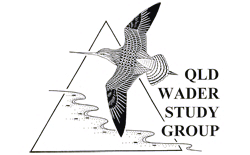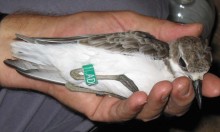The Origins of Banding
The first band used for scientific purposes was put on a European Starling (Sturnus vulgaris) in 1899 by Hans Mortenson, a Danish school teacher. Since then the use of lightweight metal bands to study birds has been widely used all over the world and most countries have access to a banding scheme to supply bands and manage the data collected. Bands have been used to study migration, population biology, monitor survival rates and understand many other aspects of avian biology, in a range of species, including many of the shorebirds. A band is a lightweight metal band, that can be closed around the leg of the bird, it has a unique code on it and an address to which the code can be sent if the bird is recovered, or found dead, providing encounter information for that individual.
Banding in Australia
The Australian Bird and Bat Banding Scheme was started in 1953 and holds a central repository for all records of birds banded, and all recoveries of banded birds either recorded in Australia and its Territories, or banded in the region and recovered locally or abroad. Large scale shorebird banding started in the 1970’s when cannon nets were first used in Australia, although there had been some limited banding before that time.
Banding of shorebirds has been conducted in all Australian states but with a focus in Victoria, North- Western Australia and Queensland.
The Use of leg Flags
Bands have a limitation in their use; normally the bird has to be recaptured, or found dead, to enable the band to be read and the individual identified. This limitation means that many birds carrying a metal band remain undetected after they have been banded and large numbers of banded individuals are often required to make a study viable.
To overcome this, leg flags have been fitted to many shorebirds to enable them to be easily identified without having to catch the bird. These were originally plain plastic flags, following an international colour convention based on locality so that anyone seeing a flag, would know from its colour which country, or region the bird had been originally banded in. These codes are managed internationally by the flyway banding schemes to ensure no duplication exists and a link to all the schemes in use can be accessed from our leg flags page. Although individuals could not be identified migration routes and stopover locations for species were quickly built up using leg flag observations, and differences between the various wintering localities were also identified.
More recently, leg flags, engraved with unique codes to identify individuals, have been used on shorebirds in North West Australia, Queensland and more recently Victoria. This new advance is now generating large numbers of resightings of individual birds, generating large amounts of information on site faithfulness and survival rates in a wide range of species.
Shorebird Banding in Queensland
Several thousand shorebirds have been banded in Queensland, mainly in Moreton Bay and primarily with plain green leg flags but since 2006 all shorebirds caught in Moreton Bay have been fitted with individually engraved leg flags. The group conduct banding operations each year aiming to catch and leg flag a sample of all the species using Moreton Bay, both resident and migratory so that comparative data is collected over many years, allowing trends to be monitored. The other pages in this section describe what we do in a lot more detail. If you are interested in banding birds or have any further questions please contact Jon Coleman, whose details are on the Contact Us page.

